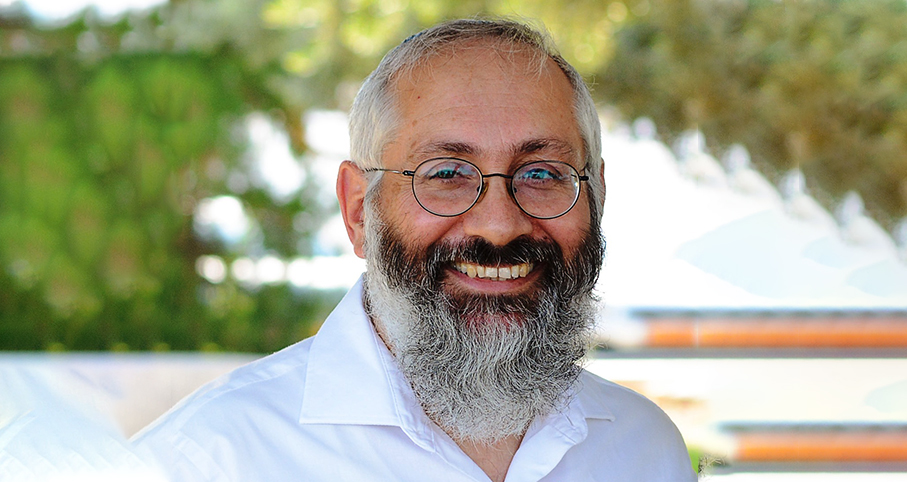Beit Midrash
- Torah Portion and Tanach
- Shmot
- Terumah
The Torah study is dedicatedin the memory of
R. Avraham ben-tziyon ben shabtai
2. Down to Earth
3. A Small Opening Above Jerusalem
4. Degrees in the Appearance of Shechina
Between Heaven and Earth
The sages open this week's Midrash on the Torah portion with praise for the Torah:
"For it is a good teaching which I have given to you; do not abandon my Torah." Do not abandon this possession which I have given to you. It happens that a man purchases an item which contains silver but not gold, or gold but not silver, yet the possession which I have given to you contains both silver - as it says, "The words of God are words of pure refined silver." - and gold - as it says, "Dearer than much gold..." It happens that a man purchases fields but not vineyards, or vineyards but not fields. Yet, this possession contains both vineyards and fields, as it says, "Your field is a vineyard of pomegranate."
(Shemot Rabbah, 33:1)
The simple meaning of the above Midrash is that the Torah is comparable to all of the good things which exist in the world: It is as precious as gold, while displaying the distinction of silver; it possesses the blessing of the fields and the sweetness of the vineyard. Yet, the deeper meaning of the Midrash is that there exists an essential unity between all of the world's goodness and the Torah. The Torah is the foundation of the world. Everything can be found in it. The sages teach that God looked into the Torah and thus created the world. Hence, the Torah constitutes the foundation and ultimate source of the existence of this world. This is the deep inner meaning of our Midrash: The Torah is the transcendent source of all the gold, silver, fields, and vineyards which exist. It is the transcendental force which confers life and continuity upon all things, and constitutes the true source for their appearance in the world.
The culmination of this idea can be found in the continuation of the words of the Midrash:
"And you will take an offering for me." Rabbi Barchia opened the discussion with the verse, "To you, God, belongs the greatness and the might... for all that is in the heavens and on the earth belongs to you." We find that all which God created up above he created down below as well. Above - lofty abodes and clouds, as it says, "Look down from heaven and see, from the lofty abode of your holiness," clouds, "and Moses approached the clouds," and as it says, "Does he judge through the clouds;" Below - "Then Solomon said, God said to dwell in clouds," and it says, "Build my house, a house of lofty abode for you."
The Midrash continues, bringing passage after passage, comparing things which belong to the realm of the heavens with their counterparts in our earthly world.
Here too, the simple understanding of the Midrash is that what we have here is a parable which points out similarities between the upper and lower worlds, and, as is the case with all parables, it comes only to draw similarity between those things being compared; and while this similarity may evidence a type of actual bond, it does not claim outright that there is, in fact, any essential connection between them.
Yet, there exists a deeper understanding, one which sees an intrinsic inner bond between the parties being compared, which sees the heavenly realm as the source of our lower world. Ours is a world which derives and unfolds from the upper world. This upper world descends level after level until finally materializing in our lower world. The Holy Temple in Jerusalem is an earthly revelation of the Holy Temple which exists in the heavens, and so it is concerning everything which one finds in our world.
Down to Earth
At this point the sages of the Midrash present us with a truly unique idea:
"What's more, that which is down below is more dear [to God] than that which is up above. Know, that God departed from that which is above and descended for that which is below, as it says "Make a temple for me, and I will dwell among them."
After it has become clear to us that all which exists in our world evolves from the upper worlds, from higher ideas clothed in and covered in physical garb, we learn that, despite this, God chose to leave the heavens and to reside on earth. It is possible, once again, to explain the words of our sages according to their simple meaning: God removed His Divine Presence, His Shechina , from the upper realms and established it in the world below. Yet, it seems that this was not the true intention of our sages, rather, the sages wished to emphasize that the Almighty is not satisfied with the dwelling of His Presence in the upper realm alone . Though one might be led to view the heavens as the more appropriate place for the dwelling of God's Shechina, the lower world being unfit for His Presence, the truth of the matter is that God loves our world in particular. He refrained from limiting His Presence to the upper spheres alone in order to bring about the dwelling of his Shechina in all levels of creation. This is precisely the purpose of the Holy Temple: to bring about the complete manifestation of the Divine Presence in the world.
A Small Opening Above Jerusalem
We may conclude from the above that when there is no Holy Temple, no Beit Mikdash in the world, the appearance of the Divine Presence remains incomplete, and therefore the Divine abundance which ought to flow out upon the world is lacking. In a similar vein, Rabbi Moshe Sofer, the famed Hatam Sofer , writes that that when the entire nation of Israel resides in the Land of Israel, Israel constitutes a spacious entrance for the manifestation of the Divine Presence in the world, an entrance through which great abundance pours down upon creation. Yet, after the Temple was destroyed and the Jews exiled from their land, this opening was reduced in size. At present there exists only a small opening above Jerusalem, above the Holy Temple, through which the entire world is nourished.
When the opening is widened, the light which flows down upon the world from the heavens widens as well. The main significance of this widening is spiritual; it reflects an expansion of the powers of the intellect and the emotion. The sages have taught that with the destruction of the Beit Mikdash, fruits lost of their flavor. True, the fruits continue to grow - abundance is possible even after the destruction of the Temple - yet they lack flavor. They lack the significance which abundance is supposed to bring to the world.
The sages have determined that there are a number of things which give man a feeling of comfort and a sense of meaning. It is possible, though, for one to possess these things and still lack contentment. When the Holy Temple stood on its foundation, the goodness which poured out upon the world served the purpose of instilling all of existence with meaning and faith, an existence in which the light of God shown upon the nation, and, in turn, upon the entire world.
Degrees in the Appearance of Shechina
There are various degrees of appearance of the Shechina in the world. With the Tabernacle which accompanied the Children of Israel in the desert, the Divine Presence appears on earth for the first time since Adam, the first man. Yet this appearance is only temporary and therefore of a lesser degree than the appearance of the Shechina in the Temple itself.
The appearance of the Shechina in the First Temple was the most significant appearance of the Divine Presence ever, and represented a permanent dwelling of the Shechina on earth. In the Second Temple, the appearance of the Divine Presence was of a lesser degree than that in the First Temple.
The sages teach that five things which existed in the First Temple, no longer existed in the Second Temple. Among those things that did not appear in the Second Temple was the Shechina. Yet, the Rambam , Rabbi Moshe ben Maimon, in his Mishneh Torah , establishes that sanctity returned to the Second Temple and will return again in the future. What's more, the Rambam gives as the reason for such the fact that the sanctity of the Second Temple evolved from the holiness of the Shechina, and the holiness of the Shechina can not completely disappear. From the words of the Rambam it appears, at any rate, that the Shechina made its dwelling even in the Second Temple. Therefore, we must conclude that there are various degrees in the appearance of the Shechina, and that our sages intended to teach us that the dwelling of the sort which existed in the First Temple no longer existed in the time of the Second Temple. In the Second Temple the Shechinah dwelled to a lesser degree. The sages have taught that even after the destruction of the Second Temple, the Shechina does not leave the Western Wall. In addition the Shechina accompanies the nation of Israel even in the exile. So, we see then, that the Shechina dwells in greater and lesser degrees.
"And Moses could not come to the Tent of Meeting, for the cloud rested upon it, and the glory of God filled the Tabernacle." The appearance of the Shechina is so clearly revealed that it appears to be actual, preventing Moses from entering the Tabernacle! We find a similar description after the establishment of the First Temple, "And the priests could not rise to serve because of the cloud, for the glory of God filled the House of God." And so, even after the establishment of the First Temple the revelation of the Shechina was so clear and impressive that it appeared to be tangible, preventing the priests from serving in the Holy Temple.
Yet after the inauguration of the Temple we do not find a similar phenomena. The Raavad , Rabbi Avraham ben David of Posquieres, claims that the sanctity of the second Temple was good in its own day but would not return in the future. He explains that the sanctity of the Third Temple will be completely different from that of the First and Second Temples, constituting an appearance of the Shechina on a much higher level than all previous manifestations. Therefore, claims the Raavad, it is impossible for the sanctity of the Second Temple to remain on the site of the Temple Mount, for in order that this great heavenly sanctification appear, all previous sanctity must be removed. We learn, then, from the Raavad, that the height of the appearance of the Shechina in the world will appear with the inauguration of the third and final temple.
------------------
Midrash - An exposition of Scripture, or collection of such, by the early Sages
Torah - The Five Books of Moses
























